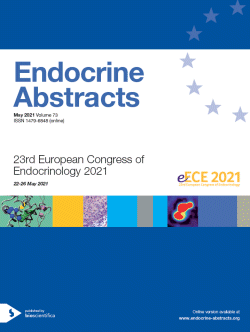
European Congress of Endocrinology 2021
Online
22 May 2021 - 26 May 2021
Presented Eposters
Presented ePosters 4: Reproductive and Developmental Endocrinology
ea0073pep4.1 | Presented ePosters 4: Reproductive and Developmental Endocrinology | ECE2021
Effect of oral contraceptives containing estradiol valerate vs. ethinyl estradiol combined with dienogest on biomarkers of coagulation – a randomized clinical trial
Haverinen Annina , Luiro Kaisu , Szanto Timea , Kangasniemi Marika , Hiltunen Leena , Sainio Susanna , Piltonen Terhi , Lassila Riitta , Tapanainen Juha , Heikinheimo Oskari
ea0073pep4.2 | Presented ePosters 4: Reproductive and Developmental Endocrinology | ECE2021
Immunological and inflammatory biomarkers in non-obese patients affected by PCOS, correlation between hormonal and metabolic parameters: preliminary data
Bruno Carmine , Vergani Edoardo , Napodano Cecilia , Pocino Krizia , Stefanile Annunziata , Gulli Francesca , Oliva Alessandro , Basile Umberto , Mancini Antonio
ea0073pep4.3 | Presented ePosters 4: Reproductive and Developmental Endocrinology | ECE2021
Effects of a very low-calorie ketogenic diet on androgen levels in overweight/obese men: a single-arm uncontrolled study
Cignarelli Angelo , Conte Eleonora , Genchi Valentina Annamaria , Giordano Fiorella , Leo Simona Di , Perrini Sebastio , Natalicchio Annalisa , Laviola Luigi , Giorgino Francesco
ea0073pep4.4 | Presented ePosters 4: Reproductive and Developmental Endocrinology | ECE2021
Insulin production by human spermatozoa in response to glucose stimuli
Carrageta David F. , Oliveira Pedro F. , Barros Alberto , Monteiro Mariana P. , Alves Marco G.
ea0073pep4.5 | Presented ePosters 4: Reproductive and Developmental Endocrinology | ECE2021
Effects of metformin withdrawal after long and short term treatment in PCOS: observational longitudinal study
Jensterle Mojca , NIka Aleksandra Kravos Tramsak , Janez Andrej
ea0073pep4.6 | Presented ePosters 4: Reproductive and Developmental Endocrinology | ECE2021
The effect of decamethylcyclopentasiloxane exposure to maternal mice in offspring behavior
Yi Donglin , Kim Kang Min , Lee Bonn , Lee Minsu , Eui-Bae Jeung
ea0073pep4.7 | Presented ePosters 4: Reproductive and Developmental Endocrinology | ECE2021
Functional ovarian reserve in women with infertility and euthyroidism: what is the role of thyroid autoimmunity?
Alexandra Festas Silva Diana , Carvalho Tânia , Maresch Ângela , Catarino Diana , Fadiga Lúcia , Reis Guiomar Joana , Gomes Leonor , Leitão Fátima , Cortesão Paulo , Almeida Santos Teresa , PAIVA Isabel
ea0073pep4.8 | Presented ePosters 4: Reproductive and Developmental Endocrinology | ECE2021
Current clinical practice of prenatal dexamethasone treatment in at risk pregnancies for classic 21‑hydroxylase deficiency in Europe
Nowotny Hanna F. , Blankenstein Oliver , Neumann Uta , Ahmed S. Faisal , Allen Stephanie , Baronio Federico , Battelino Tadej , Bertherat Jérôme , Bonomi Marco , de la Perrière Aude Brac , Tardy Véronique , Brucker Sara , Cappa Marco , Chanson Philippe , Bouvattier Claire , Colao Annamaria , Cools Martine , Davies Justin , Fenske Wiebke K. , Ghigo Ezio , Højbjerg Gravholt Claus , Hübner Angela , Husebye Eystein Sverre , Juul Anders , Kiefer Florian W. , Léger Juliane , Meyer Gesine , Phylactou Leonidas A. , Rohayem Julia , Russo Gianni , Scaroni Carla , Touraine Philippe , Unger Nicole , Hedi L. Claahsen-van der Grinten , Vojtková Jarmila , Yeste Diego , Günther Dörr Helmut , Lajic Svetlana , Reisch Nicole



